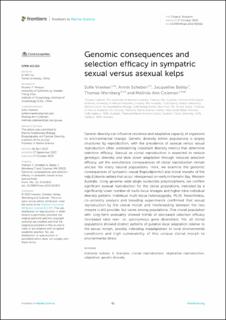| dc.description.abstract | Genetic diversity can influence resilience and adaptative capacity of organisms to environmental change. Genetic diversity within populations is largely structured by reproduction, with the prevalence of asexual versus sexual reproduction often underpinning important diversity metrics that determine selection efficacy. Asexual or clonal reproduction is expected to reduce genotypic diversity and slow down adaptation through reduced selection efficacy, yet the evolutionary consequences of clonal reproduction remain unclear for many natural populations. Here, we examine the genomic consequences of sympatric sexual (haplodiplontic) and clonal morphs of the kelp Ecklonia radiata that occur interspersed on reefs in Hamelin Bay, Western Australia. Using genome-wide single nucleotide polymorphisms, we confirm significant asexual reproduction for the clonal populations, indicated by a significantly lower number of multi-locus lineages and higher intra-individual diversity patterns (individual multi-locus heterozygosity, MLH). Nevertheless, co-ancestry analysis and breeding experiments confirmed that sexual reproduction by the clonal morph and interbreeding between the two morphs is still possible, but varies among populations. One clonal population with long-term asexuality showed trends of decreased selection efficacy (increased ratio non- vs. synonymous gene diversities). Yet, all clonal populations showed distinct patterns of putative local adaptation relative to the sexual morph, possibly indicating maladaptation to local environmental conditions and high vulnerability of this unique clonal morph to environmental stress. | en_US |
